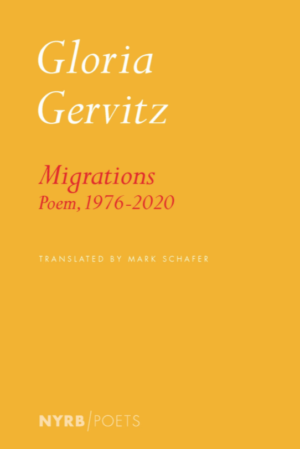Migrations
by Gloria Gervitz, translated by Mark Schafer
reviewed by Mauro G. Lazarovich
One afternoon in September 1976, the Mexican poet Gloria Gervitz wrote down a few lines that kept popping up her head. They went like this:
in the migrations of red carnations where songs burst from long-beaked birds
and apples rot before the disaster
where women fondle their breasts and touch their sex
in the sweat of rice powder and teatime
vines of passionflowers course through that which stays the same
Forty-five years later, in conversation with Mark Schafer, the translator of Migrations, she remembered that writing these lines “was like opening a faucet.” They show a remarkable consistency with the poem that Gervitz would continue writing for nearly half a century, as if the whole book had already been there: starting with the word “migration,” referring to the sway of flowers—or perhaps to their process of bloom and decay—then turning to memories, death, feminine autoeroticism, and finally, the image of coursing passionflower vines, representing both repetition and flux.
Gervitz was a poet and translator born in Mexico City who relocated to San Diego, California, where she lived until her death on April 19 of this year. Migrations is the only book that she published (in at least seven different editions in Spanish, from 1976 until now; in three editions in English—two in 2004, and now another, all translated by Schafer). It is difficult to think of a poetic project like that of Gervitz. Ezra Pound’s Cantos or Charles Olson’s The Maximus Poems come to mind, but perhaps no other modern author has consistently devoted the totality of their work to one single volume, patiently rewritten throughout the years, losing and gaining verses, and constantly mutating.
Unlike in previous editions, the poem appears now stripped of titles, prologues, capital letters, epigraphs. Gervitz leaves nothing but periods, commas, a few question marks, and the text itself: one single poem that runs, uninterrupted, for two hundred and sixty pages. Because there are no titles to separate the poem into sections, the passages spread one over the other, appearing fluid and unstable in meaning.
In the middle of the book, the poem describes a spring morning. The speaker (presumably an adolescent girl) wakes up, pushes down her underpants and starts masturbating:
[ … ] the feeling spreads
takes me completely
covers me completely
and I am this body
this rapture this vastness
I’m in the pleasure within the pleasure of pleasuring myself
At first, through repetition, the lines offer an enveloping feeling, but then they start to expand, from the intimacy of a girl’s desire to the drowsy house during the hours of siesta, the nanny “asleep in the hammock nearby,” to the market in the plaza, with its “Oaxacan tamales,” “Manila mangoes,” “sweet potatoes from Puebla,” “and roots dangling from God knows where to God knows where.” This list grows and continues for ten pages (an expansiveness stressed by the use of an anaphoric “and”); it incorporates bolero lyrics, memories of the Russian and Polish grandmothers who emigrated to Mexico, and prayers to the Virgin of Guadalupe, showing the range of the poem. It starts by focusing on something intimate, and then offers a sensorial reconstruction of a lost Mexico—the way it looked, smelled, sounded, tasted, felt.
The fragment may remind a reader of Spanish conquistador Hernán Cortés’s first encounter with the market of Tenochtitlán—the Aztec capital, in present-day Mexico City—in 1519, as he saw in ecstasy the infinite beauty of the city he would then destroy. There is, however, no destruction in Gervitz’s poem, only the slow erosion of passing time:
where’s what I’ve lived what I have thought I’d lived?
where’s the dream I once was the one I continue being?
where all those people and all those days that disappeared
like in those cemeteries with no names
no dates just shards of shattered pottery
The scene that begins with adolescent autoeroticism ends with a lament. Its lack of punctuation produces a burial ground in which past and present selves, lived and imagined experiences, are mourned together, undifferentiated.
At the beginning of the poem, Gervitz writes: “I’m not going anywhere everything is here here is there.” The unstable location of “here” in this line performs the kind of linguistic plasticity that Gervitz strives for throughout Migrations. She creates a language that seeks a here, the place that marks the position of the poetic I—which switches location as soon as it is named. This displacement is stressed by Schafer’s repetition of “here,” in a slight modification of the original Spanish, giving a changed location in its second iteration. The search for a language able to slide through different meanings in the same line, at the center of Gervitz’s poetic project, later returns in a line that borrows a metaphor from Jorge Luis Borges: “my life left no trace / water on water.” After Gervitz’s recent death, these lines acquire new and different resonances. Readers of Migrations find the trace of a life devoted to writing and rewriting—it is a mutating work, written with an ink that aspires to the flowing and dissolvent nature of running water.
Published on April 25, 2022

